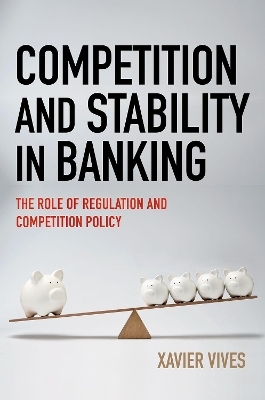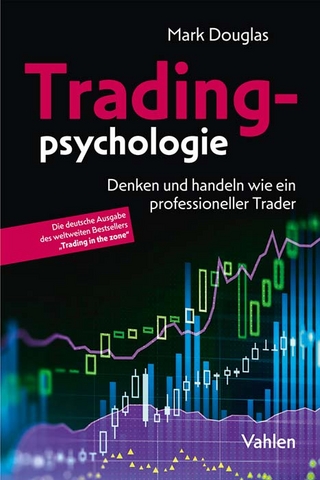
Competition and Stability in Banking
Princeton University Press (Verlag)
978-0-691-17179-1 (ISBN)
Vives argues that regulation and competition policy should be coordinated, with tighter prudential requirements in more competitive situations, but he also shows that supervisory and competition authorities should stand separate from each other, each pursuing its own objective. Vives reviews the theory and empirics of banking competition, drawing on up-to-date analysis that incorporates the characteristics of modern market-based banking, and he looks at regulation, competition policies, and crisis interventions in Europe and the United States, as well as in emerging economies. Focusing on why banking competition policies are necessary, Competition and Stability in Banking examines regulation's impact on the industry's efficiency and effectiveness.
Xavier Vives is professor of economics and finance at the IESE Business School in Barcelona. His books include Information and Learning in Markets (Princeton) and Oligopoly Pricing.
List of Figures and Tables xi Preface xiii Abbreviations xvii Chapter 1 Introduction 1 Chapter 2 Trends in Banking 7 2.1 The Expansion of the Financial Sector, Economic Growth, Financial Innovation, and Systemic Risk 10 2.1.1 Financial Sector Growth and Economic Growth 10 2.1.2 Financial Innovation and Systemic Risk 12 2.2 Business Models and the Challenge to Traditional Banking 18 2.2.1 Business Models and New Competitors 18 2.2.2 The Evolution of Competition 21 2.3 Consolidation and the Evolution of Concentration 27 Chapter 3 Fragility in Banking and the Role of Regulation 37 3.1 The Uniqueness of Banks and Fragility 37 3.1.1 The Roots of Fragility 38 3.1.2 Contagion and Systemic Risk 40 3.1.3 Social Cost of Failure 43 3.2 Shadow Banking and the 2007-2009 Crisis 44 3.3 Regulation and Financial Stability Facilities 47 3.3.1 Regulatory Aims and Tools 47 3.3.2 Prudential Regulation and the Safety Net 48 3.3.3 Bailout Distortions 50 3.3.4 Resolution 51 3.4 The 2007-2009 Crisis, Regulatory Failure, and Regulatory Reform 53 3.4.1 The 2007-2009 Crisis and Regulatory Failure 53 3.4.2 Macroprudential Regulation 56 3.4.3 Regulatory Reform 57 3.5 Regulation in Emerging/Developing Economies 64 Chapter 4 The Analysis of Competition in Banking: Theory and Empirics 70 4.1 Theoretical Models 72 4.1.1 Pricing 72 4.1.2 Product Differentiation 73 4.1.3 Frictions: Switching Costs and Asymmetric Information 74 4.1.4 Network Externalities and Two-Sided Markets 76 4.1.5 Market Structure, Entry, and New Competitors 79 4.1.6 Mergers 83 4.2 Empirical Studies 85 4.2.1 The SCP Paradigm 85 4.2.2 The New Empirical IO 88 4.2.3 The Impact of Deregulation 91 4.2.4 Asymmetric Information and Relationship Banking 93 4.2.5 Mergers 94 4.3 Behavioral Industrial Organization and Banking 97 4.3.1 Behavioral Biases and Their Impact on Consumer Behavior 98 4.3.2 Biases in Financial Markets 100 Chapter 5 Competition, Regulation, and Stability in Banking: Theory and Evidence 106 5.1 Competition and Stability: The Theory 106 5.1.1 Competition and Runs 106 5.1.2 Competition and Risk Taking 109 5.2 Competition and Stability: The Evidence 115 5.2.1 Competition and Systemic Risk 115 5.2.2 Liberalization, Risk Taking, and Systemic Risk 116 5.2.3 Concentration, Competition, and Stability 118 5.2.4 Consolidation, Diversification, Internationalization, and Stability 121 5.2.5 Lessons from the Subprime Financial Crisis 122 5.3 Interaction of Competition Policy and Regulation 124 5.3.1 The Competition-Stability Trade-Off and Regulation 124 5.3.2 The Competition-Stability Trade-Off in Emerging Economies 129 5.3.3 Coordination of Competition Policy and Prudential Regulation 130 5.4 Assessment of the Regulatory Reform Post 2007-2009 Crisis 134 Chapter 6 An Overview of Competition Policy Practice 141 6.1 The Concerns of the Competition Authorities in the EU and the UK 142 6.1.1 The EU 142 6.1.2 The UK 143 6.2 Market Definition 146 6.3 Mergers 149 6.3.1 The United States 150 6.3.2 The EU 151 6.4 Cartels and Restrictive Agreements 154 6.4.1 International Cartels 156 6.4.2 Credit Cards and Two-Sided Markets 159 6.5 State Aid in the EU 161 6.6 Consumer Protection and Behavioral Banking 163 6.6.1 The United States 166 6.6.2 The EU 168 6.7 Banking Competition Policy in Emerging Economies 170 6.7.1 Brazil 170 6.7.2 China 172 6.7.3 India 174 6.7.4 Mexico 175 6.7.5 Russian Federation 178 6.7.6 Southern Mediterranean Countries 180 Chapter 7 Competition Policy, Regulatory Architecture, and Public Intervention in the Crisis 183 7.1 Regulatory Architecture and the Competition Authority 183 7.1.1 The Design of the Financial Regulatory Architecture 183 7.1.2 The EU 190 7.1.3 The UK 195 7.2 Public Intervention, State Ownership, and Competition Distortions 199 7.2.1 Systemic Crisis, State Aid, and Competitive Distortions 199 7.2.2 State Ownership in Banking 201 7.2.3 Savings Banks 202 7.3 Competition Policy and State Aid in the EU 205 7.3.1 The 2007-2009 Crisis and Banking Resolution Tools 206 7.3.2 State Aid and Competition Distortions 209 7.3.3 Competition Policy, TBTF, and Moral Hazard 213 7.4 Merger Policy and the "Failing-Firm Defense" Doctrine 215 7.4.1 The United States 215 7.4.2 The UK 216 7.4.3 The "Failing-Firm Defense" in Banking 217 7.4.4 Spain 218 Chapter 8 Summary of Findings and Policy Implications 222 8.1 Summary of Findings 222 8.1.1 Evolution of Banking 223 8.1.2 The Role of Regulation and the Response to the 2007-2009 Crisis 224 8.1.3 The Nature of Competition in Banking 227 8.1.4 The Trade-Off between Competition and Stability 229 8.1.5 Competition Policy Practice in the Banking Sector 231 8.2 Policy Implications 233 8.2.1 Competition Policy Recommendations 233 8.2.2 Assessment of Regulatory Reform 235 8.2.3 Regulation and Competition Policy Must Be Coordinated 237 8.2.4 Regulatory Architecture 239 8.3 Challenges 241 Notes 245 References 283 Index 315
| Erscheinungsdatum | 16.08.2016 |
|---|---|
| Zusatzinfo | 20 line illus. |
| Verlagsort | New Jersey |
| Sprache | englisch |
| Maße | 152 x 235 mm |
| Gewicht | 652 g |
| Themenwelt | Wirtschaft ► Betriebswirtschaft / Management ► Finanzierung |
| Betriebswirtschaft / Management ► Spezielle Betriebswirtschaftslehre ► Bankbetriebslehre | |
| ISBN-10 | 0-691-17179-3 / 0691171793 |
| ISBN-13 | 978-0-691-17179-1 / 9780691171791 |
| Zustand | Neuware |
| Haben Sie eine Frage zum Produkt? |
aus dem Bereich


